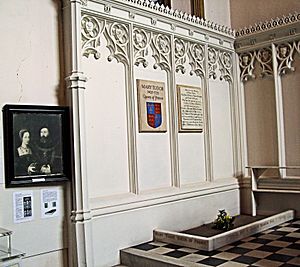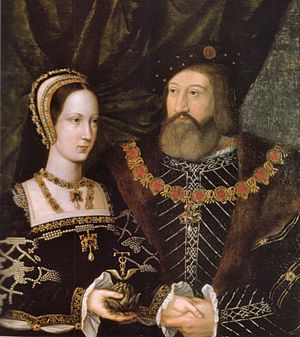Mary Tudor, Queen of France facts for kids
Quick facts for kids Mary Tudor |
|
|---|---|
| Duchess of Suffolk | |
 |
|
| Queen consort of France | |
| Tenure | 9 October 1514 – 1 January 1515 |
| Coronation | 5 November 1514 |
| Born | 18 March 1496 Sheen Palace, London, Surrey, Kingdom of England |
| Died | 25 June 1533 (aged 37) Westhorpe Hall, Westhorpe, Suffolk, Kingdom of England |
| Burial | 22 July 1533 Bury St Edmunds Abbey 1538 St. Mary's Church, Bury St. Edmunds, Suffolk |
| Spouse |
|
| Issue | |
| House | Tudor |
| Father | Henry VII of England |
| Mother | Elizabeth of York |
Mary Tudor (born March 18, 1496 – died June 25, 1533) was an English princess. She became the Queen of France for a short time. She was the third wife of King Louis XII, who was more than 30 years older than her. Mary was the fifth child of Henry VII of England and Elizabeth of York. She was the youngest of their children to survive past infancy.
After King Louis XII died, Mary married Charles Brandon, 1st Duke of Suffolk. This marriage was kept secret at first and happened without her brother Henry VIII's permission. Her brother was very angry, but a powerful advisor named Thomas Wolsey helped them. Henry VIII eventually forgave them after they paid a large fine. Mary and Charles had four children together. Through her oldest daughter, Frances, Mary was the grandmother of Lady Jane Grey. Lady Jane Grey was queen of England for only nine days in July 1553.
Contents
Growing Up as a Princess
Mary was born at Sheen Palace on March 18, 1496. She was the youngest child of King Henry VII and Queen Elizabeth of York to live past being a baby. When she was six years old, Mary got her own special household. She had ladies to help her, a teacher, and a doctor. She learned French, Latin, music, dancing, and embroidery. Her governess, Joan Vaux, was like a second mother to her.
Mary and her brother, who would become King Henry VIII, were very close friends. Henry even named his first surviving child, who later became Queen Mary I, after his sister. Mary was known for her great beauty. People said she was one of the most beautiful princesses in Europe.
In 1506, Mary helped entertain guests by dancing and playing musical instruments like the lute and clavichord. She was once promised to marry Charles, who later became a powerful emperor. However, this engagement was called off in 1513.
Becoming Queen of France
Cardinal Wolsey helped make a peace agreement with France. As part of this agreement, Mary married the 52-year-old King Louis XII of France. She was 18 years old at the time. The wedding happened on October 9, 1514, in France. Mary traveled to France with her ladies-in-waiting, including Anne Boleyn.
King Louis XII had been married twice before but had no living sons. He hoped to have a son with Mary. However, King Louis died on January 1, 1515, less than three months after their wedding. He was likely suffering from gout. They did not have any children together. After Louis's death, the new king, Francis I of France, tried to arrange another marriage for Mary, but she had other plans.
Second Marriage: Duchess of Suffolk
Mary was not happy in her arranged marriage to King Louis XII. She was already in love with Charles Brandon, 1st Duke of Suffolk. Her brother, King Henry VIII, knew about her feelings. Mary had agreed to marry Louis only if she could marry someone she loved if Louis died first. However, Henry VIII wanted any future marriage to benefit England.
When King Henry VIII sent Charles Brandon to bring Mary back to England, he made Charles promise not to propose to her. But once in France, Mary convinced Charles to break that promise. They secretly married in Paris on March 3, 1515. Only about 10 people were there, including King Francis I. Marrying a royal princess without the king's permission was a serious offense. Henry VIII was furious, and his advisors wanted Charles to be punished or even executed. Mary, as the king's sister, was safe.
Thanks to Thomas Wolsey and Henry's love for his sister and Charles, the couple only had to pay a very large fine. They officially married again on May 13, 1515, at Greenwich Palace. King Henry VIII and his court were present this time.
Mary was Charles Brandon's third wife. She helped raise his two daughters from his previous marriage along with her own children. Even after her second marriage, people at the English court often called Mary the "Queen of France." She spent most of her time at Charles's country home, Westhorpe Hall in Suffolk.
In the late 1520s, Mary and King Henry VIII had some disagreements. Mary did not support Henry's plan to end his marriage to Catherine of Aragon. Mary had known Catherine for many years. Mary also strongly disliked Anne Boleyn, who Henry wanted to marry. Anne and her sister had been among Mary's ladies-in-waiting when she went to France to marry King Louis XII.
Later Life and Death

Mary had several illnesses throughout her life. She died at Westhorpe Hall, Suffolk, on June 25, 1533, at the age of 37. She never fully recovered from a serious illness she caught in 1528. The exact cause of her death is not known, but some think it might have been tuberculosis or cancer.
Because Mary was an English princess, a king's daughter, and a former queen of France, her funeral was a very grand event. Her body was prepared and stayed at Westhorpe Hall for three weeks.
Funeral Ceremony
On July 22, 1533, people from France joined the English for the fancy funeral ceremony. Mary's daughter, Frances, was the main mourner. Mary's husband and brother did not attend, as was the custom.
The funeral procession was very long. It included 100 people carrying torches, priests, six horses pulling the coffin, other nobles, and 100 of the Duke's guards. A special church service and burial happened the next day at Bury St Edmunds Abbey.
Mary's Remains
Five years later, when the monastery was closed down, Mary's body was moved to a nearby church, St. Mary's Church, Bury St. Edmunds. In 1784, her coffin was opened, and some people took locks of her hair.
Appearance and Personality
When Mary arrived in France, she was described as "handsome and well favoured." People said she was graceful and had good manners. She was called "a paradise" for her beauty.
Her husband, Louis XII, even called her a "nymph from heaven." Mary loved to take part in plays and parties at her brother's court. She enjoyed listening to music, singing, and dancing.
Mary was known for being "very lively" and was always moving. She was also described as cheerful and friendly. When she first met her future husband, King Louis, she blew him a kiss to say hello.
Mary's Family
Mary and Charles Brandon had four children:
- Henry Brandon (born 1516 – died 1522)
- Lady Frances Brandon (born 1517 – died 1559). She married Henry Grey and was the mother of Lady Jane Grey.
- Lady Eleanor Brandon (born 1519 – died 1547). She married Henry Clifford.
- Henry Brandon, 1st Earl of Lincoln (born around 1523 – died 1534).
Mary and Charles raised their children at their home, Westhorpe Hall. Both of their sons, named Henry, died when they were children.
After Mary died, her husband Charles Brandon married a young woman named Catherine Willoughby. She was only 14 years old and had been promised to his son, Henry.
Mary Tudor in Books and Shows
Mary Tudor has been a character in many historical novels:
- When Knighthood Was in Flower by Edwin Caskoden (1898)
- The Reluctant Queen by Molly Costain Haycraft (1962)
- Mary, Queen of France by Jean Plaidy (1964)
- The Secret Bride by Diane Haeger (2008)
- Three Sisters, Three Queens by Philippa Gregory (2016)
She has also appeared in television series and films:
- In The Tudors (TV series, 2007), Mary Tudor is called Margaret. She marries the King of Portugal and later Charles Brandon.
- In The Spanish Princess (TV mini-series, 2019–2020), Mary Tudor is a main character.
- In The Sword and the Rose (film, 1953), Mary Tudor (played by Glynis Johns) falls in love with Charles Brandon (played by Richard Todd).
Images for kids
-
Mary and Louis XII of France, from a contemporary manuscript
-
Possible portrait of Mary Tudor as a teenager in the image of the Virgin, possibly Catherine of Aragon
See also
 In Spanish: María Tudor (1496-1533) para niños
In Spanish: María Tudor (1496-1533) para niños





